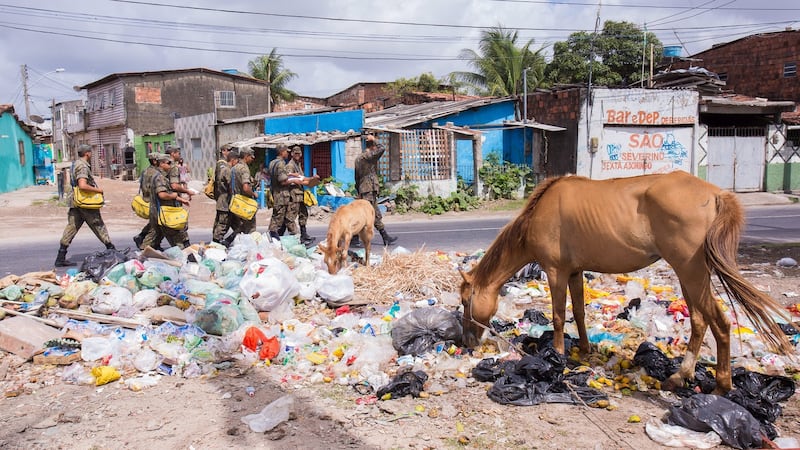When Viviane de la Ponte became pregnant just over six months ago she and her husband Thiago were, like most of Brazil, not aware of the dangers associated with the rapidly spreading Zika virus.
It was only during her third month that they saw reports in local media linking the mosquito-borne disease to a spike in in the number of babies born in Brazil with microcephaly, a neurodevelopmental disorder that causes new infants to have abnormally small heads because the brain fails to grow normally.
And then she fell ill with a fever and a nasty rash.

“The doctors are still trying to work out what I got, whether it was Zika, dengue or chikungunya,” the 28-year-old housewife says, referring to the three tropical diseases transmitted by the Aedes aegypti mosquito. “It is extremely stressful thinking I might have had Zika. It is a constant worry thinking about whether my baby was affected or not. I can’t help it but I spend a lot of my time now just crying.”
At the centre of Latin America's Zika epidemic, which has seen the virus spread rapidly across the region since its suspected arrival in Brazil in 2014, Recife is today a city gripped by fear with pregnant women on the front line. For those like de la Ponte who might have caught Zika already their pregnancy is now a battery of tests and an agonising wait to see if the disease has harmed their unborn baby.
For other expecting mothers there is the constant stress of trying to avoid being bitten by disease-carrying mosquito. Doctors advise them to use long sleeved clothing despite the searing summer heat and plenty of insect repellent. Many stay indoors as much as possible, only leaving their homes to go to work or for check-ups. Local doctors report that some patients who can afford it have gone to other regions of Brazil less affected by the disease for the remainder of their term.
This sense of fear, and the authorities’ need for caution when discussing a new and evolving threat, means that despite Brazil’s health ministry saying it has now confirmed a link between Zika and microcephaly, Recife is also a city rife with rumours and conspiracy theories.
After giving birth in the city’s Dom Pedro II hospital Jaqualine Bernardo is now waiting on the result of tests to determine if her new daughter Giovanna has microcephaly. “I used repellent all through my pregnancy and never got Zika but now they think my daughter might have this? I don’t think it is the mosquito at all. I think it was the expired vaccines,” says the 34-year-old domestic cleaner.
Like many in the city, taking their information from the turbo-charged rumour mill that is Brazilian social media, Bernardo is convinced that the mosquito is just a cover-up for the real cause of the spike in microcephaly – a supposed batch of expired rubella vaccines given to women.
Others point to a claim that the guilty party is a larvicide called pyriproxyfen that authorities add to water systems to control the spread of the Aedes aegypti mosquito. This theory was fuelled by the release of a dubiously researched report by a group of Argentine physicians promoting the link, despite World Health Organisation approval of the product which is used in the water systems of several European countries which have seen no spike in microcephaly.
Lack of information
In part rumours have been able to flourish because authorities lacked firm information about Zika and its possible link to microcephaly when the epidemic first struck Brazil. "When I first came in November the perception was we were facing an unknown threat. We didn't know who big it was going to be, how we could control it or what the consequences would be," says Professor Laura Rodrigues of the London School of Hygiene and Tropical Medicine who is helping lead one of the Zika task forces back in her native Brazil.
But since then teams of Brazilian and international researchers have made great strides. “This is a tragedy because the numbers involved are so large and pregnancy is a very emotional moment,” says Rodrigues. “But at the same time we are developing new knowledge. Now we all agree that the evidence of causality between Zika and microcephaly is strong enough to justify public health actions.”
If Brazil’s underfunded public health system has struggled to deal with the epidemic, researchers like Rodrigues say that its public health notification system has worked well, picking up the spike in Zika and suspected microcephaly early, allowing authorities to quickly orientate pregnant women on how to try and protect themselves.
This early warning system also means that the number of eventual confirmed cases of microcephaly will likely be less than the 4,107 suspected cases under investigation. “It is still an enormous epidemic but the numbers will be less than initially suspected,” says Rodrigues.
Now the race is on to find a vaccine though that could take several years. The population is also being monitored to see if once infected with Zika, humans develop an immunity to the virus. That might mean that in the future women could get pregnant safely if they have previously caught the disease whose impact on non-pregnant women is otherwise relatively mild.
But Brazil still faces a long war against the Aedes aegypti mosquito, whose infected bites also left 1.6 million people with dengue last year, killing 863. It thrives in the pools of standing water, clean and stagnant, that are a common feature of poor neighbourhoods in a country where only 50 per cent of the population is connected to the sewage system.
"Brazil's hot and wet climate favours the mosquito already," says Jesse Alves Reis, an infectologist at São Paulo's Clínicas hospital. "But it also benefits from our poor public sanitation and that problem is not solved overnight."















